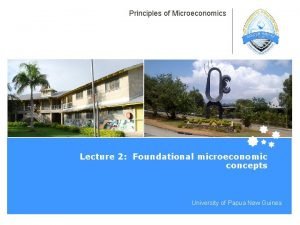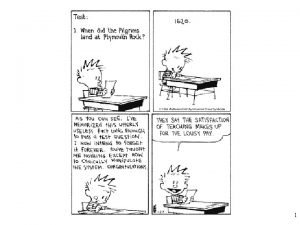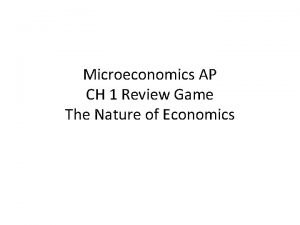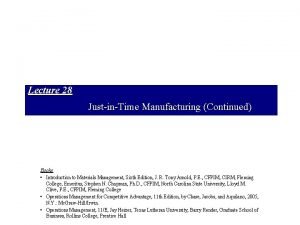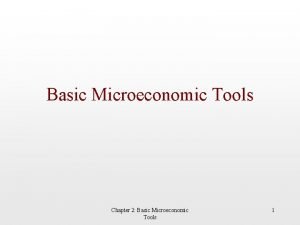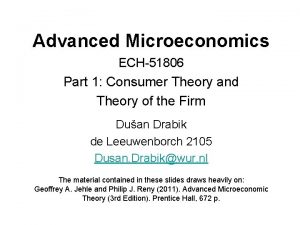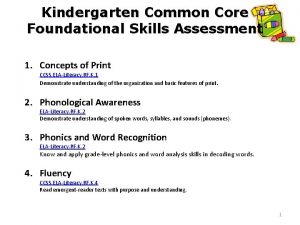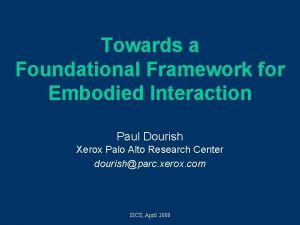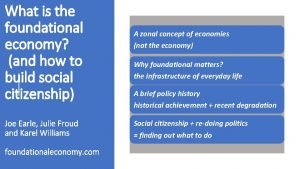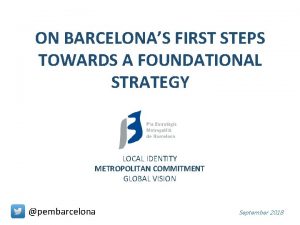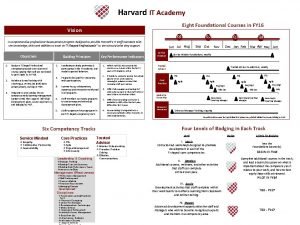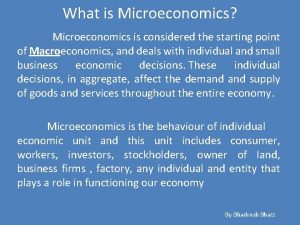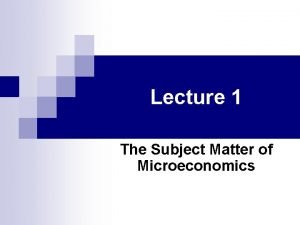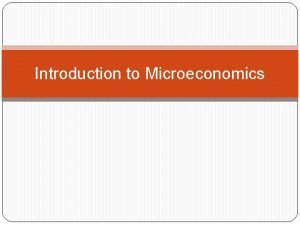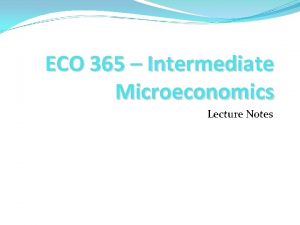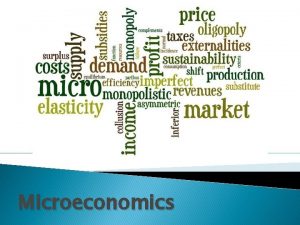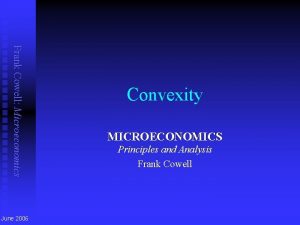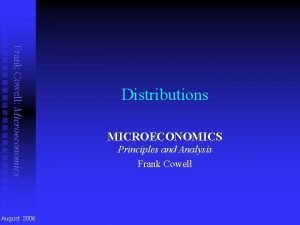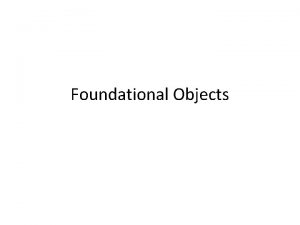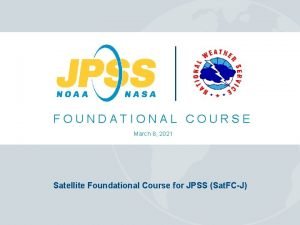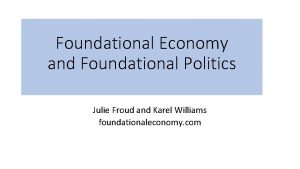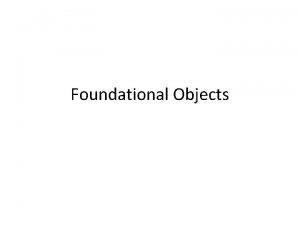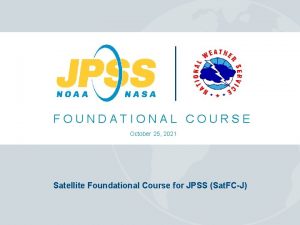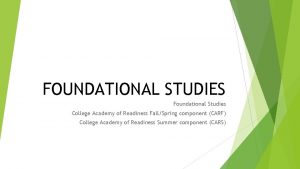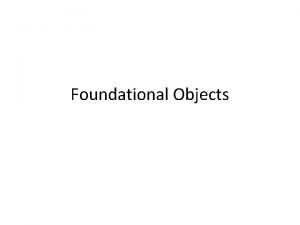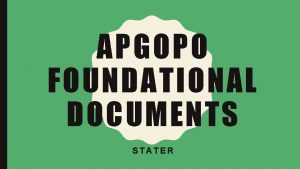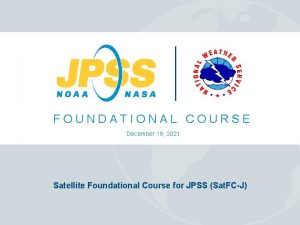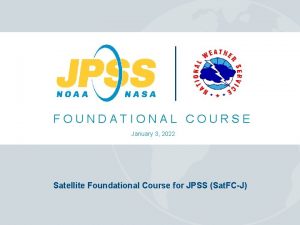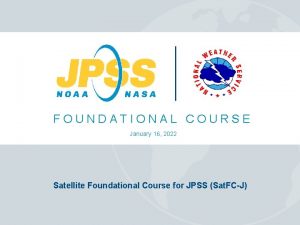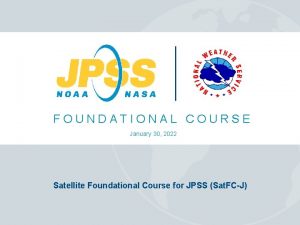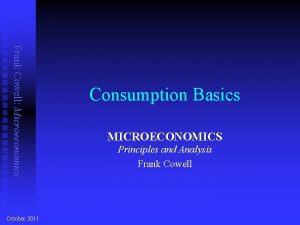Principles of Microeconomics Lecture 2 Foundational microeconomic concepts
























- Slides: 24

Principles of Microeconomics Lecture 2: Foundational microeconomic concepts University of Papua New Guinea

Lecture 2: Foundational microeconomic concepts Michael Cornish Overview • Production possibility frontiers • Proving gains from trade • Factors of production • The importance of property rights to trade • The Circular Flow Model Slide 1 The University of Papua New Guinea

Lecture 2: Foundational microeconomic concepts Michael Cornish Production possibility frontiers • PPFs and PPCs • Illustrate the principle of opportunity cost • Shows the all of the possible combinations of two products that can be produced – Hence the name: production possibility curve! Slide 2 The University of Papua New Guinea

Lecture 2: Foundational microeconomic concepts Michael Cornish Production possibility frontiers • Assumptions: – Fixed resources – Fixed technology – Productive efficiency – Full employment – For our purposes, two products only (although you could always draw in more products across more dimensions…) Slide 3 The University of Papua New Guinea

Lecture 2: Foundational microeconomic concepts Michael Cornish Production possibility frontiers • Example: Type of product Capital ($bn) Consumer ($bn) Slide 4 Production alternatives a b c d e 0 1 2 3 4 15 14 12 9 5 f 5 0 The University of Papua New Guinea

Lecture 2: Foundational microeconomic concepts Michael Cornish Production possibility frontiers Consumer goods 15 a b Unattainable c 10 d Attainable 5 z e f 0 Slide 5 1 2 3 4 5 Capital goods The University of Papua New Guinea

Lecture 2: Foundational microeconomic concepts Michael Cornish Production possibility frontiers a Consumer goods 15 b Increasing (marginal) opportunity cost of capital goods c 10 d e 5 f 0 Slide 6 1 2 3 4 5 Capital goods The University of Papua New Guinea

Lecture 2: Foundational microeconomic concepts Michael Cornish Production possibility frontiers • How does economic growth affect the PPC? • How does technological progress affect the PPC? • How does an increase in population affect the PPC? • What if I told you that consumer products were more labour-intensive? Slide 7 The University of Papua New Guinea

Lecture 2: Foundational microeconomic concepts Michael Cornish Production possibility frontiers • More questions to think about: – Is it possible to have a concave PPC? – What about a straight-line PPC? – For those that are possible, what could we say about the opportunity cost? Slide 8 The University of Papua New Guinea

Lecture 2: Foundational microeconomic concepts Michael Cornish Proving gains from trade • Why do we trade? • And why do we specialise? • Absolute advantage: – The ability to produce more of a product than other producers using the same amount of resources Slide 9 The University of Papua New Guinea

Lecture 2: Foundational microeconomic concepts Michael Cornish Proving gains from trade • Comparative advantage: – The ability to produce a product at a lower opportunity cost than other producers Slide 10 The University of Papua New Guinea

Lecture 2: Foundational microeconomic concepts Michael Cornish Proving gains from trade • Example: – Sugar industry and financial services industry in Australia and Fiji – Does Australia have an absolute advantage or a comparative advantage in financial services? – Does Australia have an absolute advantage or a comparative advantage in sugar? Slide 11 The University of Papua New Guinea

Lecture 2: Foundational microeconomic concepts Michael Cornish Proving gains from trade An example with numbers. . . • Harry and Sally live together and like to cook pizzas and garlic bread. Here is the maximum each can produce in an hour: Harry Sally Slide 12 Pizzas (P) 4 5 Garlic Bread (G) 1 4 The University of Papua New Guinea

Lecture 2: Foundational microeconomic concepts Michael Cornish Proving gains from trade Harry Sally Pizzas (P) Garlic Bread (G) 4 5 1 4 Step 1: Plot their PPCs For one hour: Harry GB Pizzas Sally GB Pizzas Note: Sally has an absolute advantage in both! Slide 13 The University of Papua New Guinea

Lecture 2: Foundational microeconomic concepts Michael Cornish Proving gains from trade Pizzas (P) Garlic Bread (G) 4 5 1 4 Harry Sally Step 2: Compare opportunity costs • Pizzas: • Harry: 1 pizza costs him 1/4 of a garlic bread => 1 P : 0. 25 G • Sally: 1 pizza costs her 4/5 of a garlic bread => 1 P : 0. 8 G Harry has a lower cost of making pizzas (in terms of garlic bread) than Sally => Harry has a comparative advantage in producing pizzas Slide 14 The University of Papua New Guinea

Lecture 2: Foundational microeconomic concepts Michael Cornish Proving gains from trade Harry Sally Pizzas (P) Garlic Bread (G) 4 5 1 4 Step 2 (cont. ) Garlic Bread: • Harry: 1 garlic bread costs him 4 pizzas => 1 G : 4 P • Sally: 1 garlic bread costs her 5/4 of a pizza => 1 G : 1. 25 P Note: These ratios are just the inverse of those we calculated with pizzas! Sally has a lower cost of making garlic bread (in terms of pizzas) than Harry => Sally has a comparative advantage in producing garlic bread Slide 15 The University of Papua New Guinea

Lecture 2: Foundational microeconomic concepts Michael Cornish Proving gains from trade Harry Sally Pizzas (P) Garlic Bread (G) 4 5 1 4 Step 3: Set a world price What is the ‘world price’ in our closed world of Harry and Sally? It must be within the range of their opportunity costs, as this establishes the limits of their willingness to trade. Þ Therefore both Harry and Sally can gain from specialisation I. e. Harry will only trade a pizza if he gets more than 1/4 of a garlic bread in return Sally will only trade garlic bread if she gets more than 5/4 of a pizza in return Slide 16 The University of Papua New Guinea

Lecture 2: Foundational microeconomic concepts Michael Cornish Proving gains from trade Pizzas (P) Garlic Bread (G) 4 5 1 4 Harry Sally Step 3 (cont. ): So what do we do? Assume that both Harry and Sally specialise and trade at a price between these limits E. g. Somewhere between 1 P : 0. 25 G and 1 P : 0. 8 G (or, in terms of 1 pizza, between 1 G : 1. 25 P and 1 G : 4 P) So let’s set our world price at 1 P : 0. 5 G (this is the same as 1 G: 2 P) Slide 17 The University of Papua New Guinea

Lecture 2: Foundational microeconomic concepts Michael Cornish Proving gains from trade Pizzas (P) Garlic Bread (G) 4 5 1 4 Harry Sally Step 3: Calculate a trade that works! Harry produces 4 pizzas and 0 garlic bread Sally produces 0 pizzas and 4 garlic breads At the world price (1 P : 0. 5 G) Harry trades 2 pizzas for 1 garlic bread / Sally trades 1 garlic bread for 2 pizzas After trade: Harry has 2 pizzas and 1 garlic breads Sally has 2 pizzas and 3 garlic breads Slide 18 The University of Papua New Guinea

Lecture 2: Foundational microeconomic concepts Michael Cornish Proving gains from trade Step 4: Check on the PPC Harry GB Consumes Produces Pizzas Sally Produces GB Consumes Pizzas Conclusion: They can consume more with trade! Slide 19 The University of Papua New Guinea

Lecture 2: Foundational microeconomic concepts Michael Cornish Proving gains from trade Extension: Ranges of possible trades Harry GB Slide 20 Pizzas Sally GB Pizzas The University of Papua New Guinea

Lecture 2: Foundational microeconomic concepts Michael Cornish Factors of production • Labour (‘L’) – Income paid on labour is a wage • Capital (‘K’) – Income paid on capital is rent (or interest) • Land (‘T’) (but the category is broader than ‘land’!) – Income paid on land is rent • Entrepreneurship – Income paid on entrepreneurship is profit Slide 21 The University of Papua New Guinea

Lecture 2: Foundational microeconomic concepts Michael Cornish The importance of property rights to trade • What are property rights? – The exclusive (‘inalienable’) use of property, including the right to buy or sell it • Important to: – Increase certainty in economic transactions… …and thus mitigate risk! • Acts as a precondition for effective markets – An aside: property rights in centrally planned economies… Slide 22 The University of Papua New Guinea

Lecture 2: Foundational microeconomic concepts Michael Cornish The Circular Flow Model Slide 23 The University of Papua New Guinea
 Microeconomic
Microeconomic Intermediate microeconomics lecture notes
Intermediate microeconomics lecture notes Ap microeconomics unit 1 basic economic concepts
Ap microeconomics unit 1 basic economic concepts Rent principles of microeconomics
Rent principles of microeconomics Example for microeconomics
Example for microeconomics Nortmative
Nortmative Kanban microeconomic theory
Kanban microeconomic theory Microeconomic
Microeconomic Microeconomic
Microeconomic Foundational skills definition
Foundational skills definition Foundational public health services
Foundational public health services Foundational marketing
Foundational marketing Foundational skills assessment
Foundational skills assessment Foundational marketing
Foundational marketing Foundational community supports
Foundational community supports Foundational framework meaning
Foundational framework meaning Foundational marketing
Foundational marketing Foundational economy
Foundational economy Foundational strategy
Foundational strategy Harvard it academy
Harvard it academy 01:640:244 lecture notes - lecture 15: plat, idah, farad
01:640:244 lecture notes - lecture 15: plat, idah, farad What is microeconomics
What is microeconomics What is the subject matter of microeconomics
What is the subject matter of microeconomics Limitation of microeconomics
Limitation of microeconomics Intermediate microeconomics notes
Intermediate microeconomics notes
